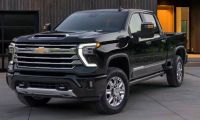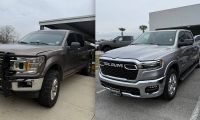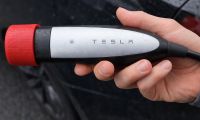The company claims to have created the most advanced electric drive system for hybrid, plug-in hybrid and light duty battery-powered electrics applicable to existing vehicles. Their system reportedly improves fuel efficiency as the Protean-equipped Vivaro van achieved 114 mpg in hybrid mode, three times the fuel economy of the conventional Vivaro on the New European Drive Cycle (an efficiency/emissions test for urban vehicles).
In addition, the patented direct-drive design reports the highest torque and power density of any electric propulsion system, while incorporating the motor control electronics and regenerative braking inside each motor assembly. Each in-wheel motor can deliver 110 hp (81kW) and 590 lb.-ft. (800Nm) or torque, but weighs only 68 lbs and can fit into a conventional 18-inch road wheel.
"Our technology is uniquely designed for a broad range of vehicle applications," said Bob Purcell, chairman and CEO of Protean. "Our in-wheel motors are unique in that they have the rotor on the outside and each motor's electronics on the inside. That simplicity of the design creates more power density per motor and much simpler vehicle integration. It's the closest thing to a bolt-on hybrid system."
The wheel motors can power a variety of battery electric vehicles or can be added to a FWD or RWD car or truck with an internal combustion engine, effectively converting it to a hybrid. In this mode, the drive system is selectable, between three modes: all electric, hybrid or all gas/diesel. They also can provide fully independent torque control.
The company insists it can be added to vehicles relatively easily, creating a hybrid or plug-in hybrid configuration from an existing conventional vehicle to save fuel, emissions and greenhouse gases, and add torque and power, regardless of whether the vehicles use gas, diesel or alternative fuels.
As there is no need for major changes in engine, drivetrain or emissions components, manufacturers could potentially use the Protean Drive to augment engine start-stop systems and allow the design of vehicles with even smaller and more efficient internal combustion engines.
"Protean Electric's patented in-wheel motor design with distributed architecture revolutionizes the integration of electric propulsion and propulsion assist for mass production vehicles," Purcell said. "It has the potential to revolutionize the automotive industry and provide the crucial bridge to wider scale adoption of electric and hybrid vehicles."
Our interview with Debbie Frakes, a spokesperson for Protean Electric, follows in its entirety:
TorqueNews: First, does the system require its own battery and if not where does the power to drive the individual wheel motors come from?
Debbie Frakes: Yes. Energy storage or a battery should be mounted separately in the vehicle. Since we have power electronics packaged inside each wheel motor, there are fewer “black boxes” of power electronics that must be mounted separately on board. That can cut down on the amount of high voltage cable required on board the vehicle. This can save vehicle costs. We are “battery agnostic” in the sense that Protean Drive is compatible with most every hybrid , PHEV, or EV battery system regardless of manufacturer. Also, we can provide the basis of a family of vehicles from hybrid to PHEV, to EV, all using the same vehicle and the same Protean Drive powertrain system. All that is needed is to scale up the battery (more kW-hr.) energy storage capacity for each application.
TN: How long has the system been in development?
DF:
1963 PML Flightlink Established (prior company)
2003 Focus on wheel motor technology
2006 First public debut of the Protean’s technology
2007 First OEM vehicle shown to the public with Protean Drive system
2008 Protean Electric system demonstrated in Ford F-150 pick -p truck
2009 Protean Electric and PML Flightlink split. Protean Electric purchased by Oak Investment Partners of Palo Alto, California
2010 Protean gains global OEM interest with demonstration vehicles operating simultaneously in the US, Europe and Asia
TN: To what extent has it been real world tested?
DF: We have four “proof-of-concept” vehicles currently: a Ford F150, a Vauxhall Vivaro commercial van, a GAC Trumpchi (display only at this point) and the Volvo ReCharge, based on the Volvo C30. Each of those vehicles helps with a variety of demonstration and test activities. We also have a “mule vehicle” with wheel motors being tested full time on our 4 wheel chassis dynamometer test lab in Farnham, England. There, we also have 2 single-motor dynos in use.
TN: Can you provide references to anyone who has used Protean to convert an existing vehicle to hybrid power?
DF: We have worked cooperatively in a joint program with Millbrook, Proving ground, one of Europe’s leading test and validation facilities, to retrofit a production Vauxhall Vivaro commercial van. We are currently developing a retrofit package that will be a solution for existing vehicles and are in talks with several fleet companies both in the United States and Europe.










